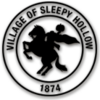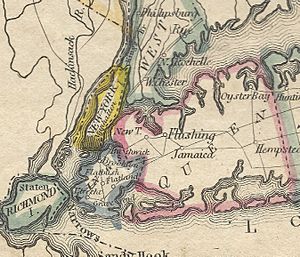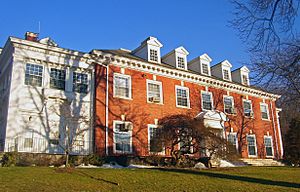Sleepy Hollow, New York facts for kids
Quick facts for kids
Sleepy Hollow, New York
|
||
|---|---|---|

The Old Dutch Church in 1907
|
||
|
||
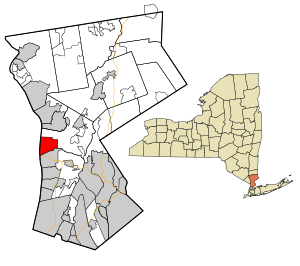
Location of Sleepy Hollow, New York
|
||
| Country | United States | |
| State | New York | |
| County | Westchester | |
| Town | Mount Pleasant | |
| Area | ||
| • Total | 5.21 sq mi (13.48 km2) | |
| • Land | 2.24 sq mi (5.81 km2) | |
| • Water | 2.96 sq mi (7.67 km2) | |
| Elevation | 89 ft (27 m) | |
| Population
(2020)
|
||
| • Total | 9,986 | |
| • Density | 4,452.07/sq mi (1,718.85/km2) | |
| Time zone | UTC-5 (Eastern (EST)) | |
| • Summer (DST) | UTC-4 (EDT) | |
| ZIP code |
10591
|
|
| Area code(s) | 914 | |
| FIPS code | 36-67638 | |
| GNIS feature ID | 0958934 | |
Sleepy Hollow is a village in Westchester County, New York. It is part of the town of Mount Pleasant in the United States.
This village sits on the east bank of the Hudson River. It is about 20 miles north of New York City. You can reach it by train using the Metro-North Hudson Line. To the south is Tarrytown, and to the north and east are other parts of Mount Pleasant. In 2020, about 9,986 people lived here.
Sleepy Hollow was first called North Tarrytown when it became a village. This was in the late 1800s. The first Dutch settlers arrived over 200 years before that. They called the area "Slapershaven," meaning "Sleepers' Haven." The village changed its name to Sleepy Hollow in 1996.
The village is famous because of "The Legend of Sleepy Hollow." This short story was written in 1820 by Washington Irving. It tells about the area and its spooky character, the Headless Horseman. Irving lived nearby and is buried in Sleepy Hollow Cemetery. Many other important people are buried there too. Because of "The Legend" and its old history, some people think Sleepy Hollow is one of the "most haunted places in the world." But it's also known as "one of the safest places to live."
Contents
History of Sleepy Hollow
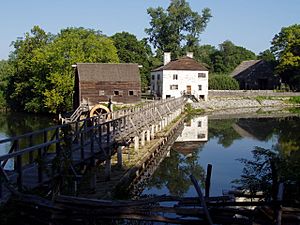
Early Settlers and Land Ownership
The land that is now Sleepy Hollow was first home to the Weckquaesgeck Indians. They were part of the Delaware or Mohican tribes. In 1609, Henry Hudson claimed the Hudson Valley for Holland. There was peace between the Native Americans and Dutch for many years.
Later, the land was bought from Adriaen van der Donck. He was a land owner in New Netherland. This was before the English took over in 1664. In 1672, Frederick Philipse started buying large areas of land. This land was mostly in what is now southern Westchester County. It covered about 52,000 acres.
The Manor of Philipsburg
In 1693, Philipse was given a special royal paper. This created the Manor of Philipsburg. He became the first lord of this manor. In Sleepy Hollow, he built a mill and a shipping area. Today, this is part of the Philipse Manor House historic site. Philipse was a religious man. He helped build the town's Old Dutch Church of Sleepy Hollow. People say he even built the pulpit with his own hands.
When Philipse died in 1702, his land was split. His son, Adolphus Philipse, got the Upper Mills property. This land stretched from Dobbs Ferry to the Croton River. His grandson, Frederick Philipse II, got the Lower Mills. When Adolphus died, the two parts of the manor were joined again. His son, Frederick Philipse III, became the third lord in 1751.
Revolutionary War and Land Changes
During the American Revolutionary War, Frederick III was a Loyalist. This meant he supported the British. In 1779, his land was taken away. It was sold to 287 different buyers. The biggest part of the land was about 750 acres. It was at the Upper Mills. This land changed hands many times. In 1951, Sleepy Hollow Restorations bought it. Thanks to John D. Rockefeller Jr., about 20 acres were made into the historic site you can visit today.
Washington Irving and "The Legend"
In the late 1790s, Washington Irving visited Sleepy Hollow. He came with his friend James K. Paulding. Paulding was a local soldier who helped capture a British Major during the war. Irving and Paulding explored the area. They hunted, fished, and talked with the local people. Irving heard many old stories and ghost tales. These visits and stories later became famous in his book, "The Legend of Sleepy Hollow."
Geography of Sleepy Hollow
Sleepy Hollow is located at 41.091998 degrees North and -73.864361 degrees West. The United States Census Bureau says the village covers about 5.1 square miles. About 2.3 square miles of this is land. The other 2.8 square miles, or 55.58%, is water.
Population and People
| Historical population | |||
|---|---|---|---|
| Census | Pop. | %± | |
| 1880 | 2,684 | — | |
| 1890 | 3,179 | 18.4% | |
| 1900 | 4,241 | 33.4% | |
| 1910 | 5,421 | 27.8% | |
| 1920 | 5,927 | 9.3% | |
| 1930 | 7,417 | 25.1% | |
| 1940 | 8,804 | 18.7% | |
| 1950 | 8,740 | −0.7% | |
| 1960 | 8,818 | 0.9% | |
| 1970 | 8,334 | −5.5% | |
| 1980 | 7,994 | −4.1% | |
| 1990 | 8,152 | 2.0% | |
| 2000 | 9,212 | 13.0% | |
| 2010 | 9,870 | 7.1% | |
| 2020 | 9,986 | 1.2% | |
| U.S. Decennial Census | |||
How Many People Live Here?
In 2010, there were 9,870 people living in Sleepy Hollow. There were 3,181 households, which are groups of people living together. About 2,239 of these were families. The village had about 4,054.7 people per square mile. There were 3,253 housing units, like houses or apartments.
Diversity in Sleepy Hollow
The people in Sleepy Hollow come from many different backgrounds. In 2010, about 61.0% of residents were White. About 6.2% were African American, and 0.8% were Native American. About 3.3% were Asian. A large group, 23.5%, were from other races. About 5.2% were from two or more races.
Many people in Sleepy Hollow are of Hispanic or Latino background. They made up 51.0% of the population. Many of them are from Ecuador, Dominican Republic, Chile, and Puerto Rico. Sleepy Hollow has one of the highest numbers of Ecuadorian American residents in the country. About 17.5% of the population was Ecuadorian American in 2010.
Families and Age Groups
Out of all households, 36.0% had children under 18 living with them. About 51.5% were married couples. About 13.4% were single mothers. And 29.6% were not families. About 23.0% of households had just one person living there. About 8.7% had someone aged 65 or older living alone. The average household had 2.89 people. The average family had 3.37 people.
The population had different age groups. About 25.0% were under 18 years old. About 8.9% were 18 to 24. The largest group, 36.7%, was 25 to 44 years old. About 18.9% were 45 to 64. And 10.5% were 65 or older. The average age in the village was 34 years. For every 100 females, there were about 103 males.
Notable Landmarks in Sleepy Hollow
Sleepy Hollow has many important historical places. These include the Philipsburg Manor House and the Old Dutch Church of Sleepy Hollow. Also, Patriots Park is a key site. All of these are listed as National Historic Landmarks.
Other important local sites are on the National Register of Historic Places. These include the Sleepy Hollow Cemetery and the Edward Harden Mansion. The mansion is now used by the Public Schools of the Tarrytowns. The Philipse Manor Railroad Station is also listed. It is now used by the Hudson Valley Writers Center. You can also find the Tarrytown Light and parts of the Old Croton Aqueduct here.
Other interesting places include Kingsland Point Park. Some say it's haunted by the ghost of Captain Kidd. There's also the Philipse Manor Beach Club. Sleepy Hollow Manor is a neighborhood on the old land of explorer John C. Frémont. His updated house still looks over the Hudson River. The Rockefeller State Park Preserve is also nearby.
Emergency Services in Sleepy Hollow
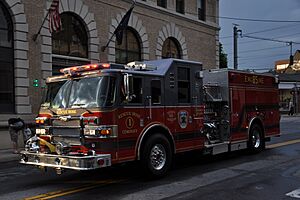
Police Department
As of 2014, the village's police department had 27 officers. They also had four school crossing guards and three other employees. The New York State Police and Westchester County Department of Public Safety also help the village. Police officers from Sleepy Hollow, Dobbs Ferry, and Greenburgh work together. They form a special Marine / H.E.A.T. Unit.
Fire Department
The Sleepy Hollow Fire Department started in 1876. It was first called the North Tarrytown Fire Patrol. Within 25 years, it grew to five companies in three fire stations. As of 2019, they have three fire engines, one tower ladder, and other equipment. The fire department is run by volunteers. They respond to over 300 calls every year.
Medical Services
Emergency medical services in Sleepy Hollow rely on volunteers. They are also helped by paid staff. The Ambulance Corps has two ambulances for basic life support. Mount Pleasant Paramedics provides more advanced life support. The local hospital, Phelps Memorial, helps with many emergencies each year.
Education in Sleepy Hollow
Most of the schools in Sleepy Hollow are part of the Union Free School District of the Tarrytowns. A smaller part of the village is in the Pocantico Hills Central School District.
Notable People from Sleepy Hollow
Many interesting people have lived in Sleepy Hollow:
- Wolfert Acker (1667–1753), a person from colonial times, mentioned in Washington Irving's stories.
- Bob Akin (1936–2002), a business leader and race car driver.
- Fay Baker (1917–1987), an actress and writer.
- Kathleen Beller, an actress.
- David Bromberg, a musician who plays string instruments.
- Ana Cabrera, a television journalist.
- Keith Hamilton Cobb, an actor known for The Young and the Restless.
- Sam Coffey, a professional soccer player for the Portland Thorns and the U.S. Women's National Team.
- Abraham de Revier Sr. (around 1650–1720), an early American historian.
- Vincent Desiderio, a realist painter.
- Karen Finley, a performance artist.
- John C. Frémont (1813–1890), a military officer, explorer, and politician. He was the first Republican candidate for President.
- Margaret Hardenbroeck (around 1637–1690), a merchant in colonial New York.
- Elsie Janis (1889–1956), a singer, songwriter, and actress.
- Mondaire Jones, a former U.S. Representative.
- Tom Keene (1896–1963), an actor in films like Our Daily Bread.
- Ambrose Kingsland (1804–1878), a wealthy merchant and mayor of New York City.
- Karl Knortz (1841–1918), a German-American author.
- Leatherman (around 1839–1889), a famous traveler from the 1800s.
- Joseph L. Levesque, a former President of Niagara University.
- Joan Lorring (1926–2014), an actress nominated for an Academy Award.
- Ted Mack (1904–1976), a radio and TV host.
- Cyrus Margono, a professional soccer player.
- Ralph G. Martin (1920–2013), an author and journalist.
- Donald Moffat (1930–2018), a British actor.
- Frank Murphy (1876-1912), a Major League Baseball player.
- Eric Paschall, an NBA basketball player.
- Frederick Philipse (around 1626–1702), the first Lord of the Manor of Philipsburg.
- Nelson Rockefeller (1908–1979), a businessman, politician, and the 41st Vice President of the United States.
- Adam Savage, co-host of the TV show MythBusters.
- Gregg L. Semenza, a Nobel Prize-winning doctor and researcher.
- Dirck Storm (1630–1716), an early American known for his writings about Dutch village life.
- Tony Taylor, an NBA basketball player.
- Worcester Reed Warner (1846–1929), an engineer, astronomer, and giver to charity.
- General James Watson Webb (1802–1884), a U.S. diplomat and newspaper publisher.
See also
 In Spanish: Sleepy Hollow (Nueva York) para niños
In Spanish: Sleepy Hollow (Nueva York) para niños


